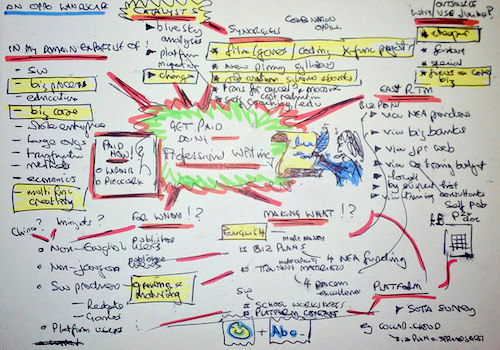NaNo Prep: How to Make a Timeline

As we dive into NaNo Prep season, we’ve talked to some participants to get the inside scoop on how to best prepare for November. Today, participant Juliana Xavier shares how to plan out your story, even if you’re a committed pantser:
When you think about NaNoWriMo, do you find that your palms are sweaty, knees weak, arms… heavy? If so, congratulations, Rabbit, you’re in the process of panicking about the grueling (yet fun!) month of noveling that is fast approaching (sans spaghetti, I hope).
Not to worry, I––a six-year veteran of NaNoWriMo––am here to teach you everything you need to know. I even succeeded in reaching the 50k goal during my very first year.
Here’s what my prep the week before November 1st looked like that time:
Denial (that I could ever write a novel)Anger (that I’d set myself up to fail)
Bargaining (in hopes that 50k words would magically show up in my word document)
Depression (just, uncontrollable sobbing)
Acceptance (might as well get it over with, since I set up a profile and everything)
The following years were all about false hope. I had done it once before. All I had to do was repeat the previous year’s recipe. No real prep necessary as long as I had a story in mind. Easy peasy right?
Narrator: It wasn’t.
All kidding aside, it took me years to find a prep style that worked. By the third year, I started moving from pantser to plotter. The first years were spent simply trying to prove to myself that I could write 50k. It didn’t matter what I wrote as long as I hit that number. I’d proven to myself that I could, now I needed to find a way to do it coherently: a story with beginning, middle and end.
That’s where timelining comes in. If you’ve never done a timeline before, it’s what bullet journaling is to a diary entry: a way to list the most important facts of your story, in a way as to not lose yourself (that Eminem song’s gonna be stuck in my head for at least a week now).
No dialogue, no senseless descriptions, no drama, no fluff. Just a grocery style list of things that need to happen in your story.
Start with your main plot points:Hero leaves home.Hero meets new friends.
New friends betray the hero.
Epic battle!
Hero returns home changed.
Then, break those down even further, trying to figure out the different drives that move the story forward.
Part 1:Hero doesn’t want to leave.Hero’s home is mysteriously burned down.
Hero has nothing left.
Hero leaves home.
Not enough? Break it down some more! Break down individual chapters if you have to. Just remember to start simple so you don’t get lost within plot.
How many times you break it down is up to you, but I find that three times does the trick. More than that and you’re just using the timeline as an excuse not to get actual work done… (guilty!)
And that’s it!
So, whether you’re the type of person who offers up your kid brother to the gods in exchange for uninterrupted hours of enlightened writing; or you dance half naked in (preferably) your own backyard during the full moon, chanting the wrong song lyrics to whatever tune is stuck in your head that week… I think it’s safe to say that there’s no real bad way to prep for something as important as writing your very own novel.
But if you’re still stuck? Try a timeline! We’ll be cheering you on just the same.
Signed,
Your friendly neighborhood Wrimo participant.

Juliana Xavier is a writer, illustrator and has a BFA in Sequential Arts from SCAD University. Brazilian born but partially American grown. Works as a freelance artist and would love to draw your fantasy maps and covers for books. Hates coffee (gasp!) but thinks that Thai bubble tea makes everything right with the world. You can find her on her portfolio website, Twitter, Patreon, and Facebook page. For inquiries, feel free to e-mail her at juliana.m.xavier@gmail.com
Top image licensed under Creative Commons from Julian Partridge on Flickr.
Chris Baty's Blog
- Chris Baty's profile
- 63 followers



